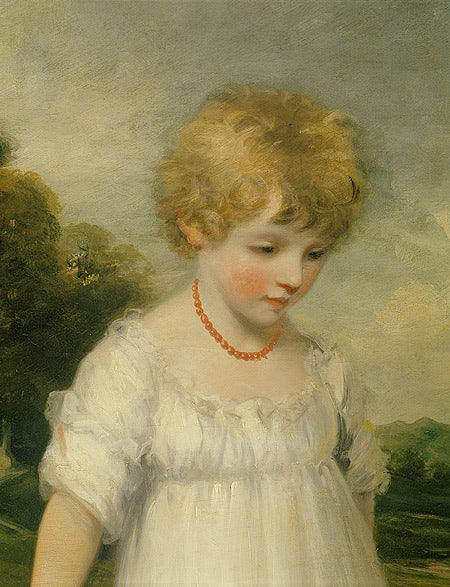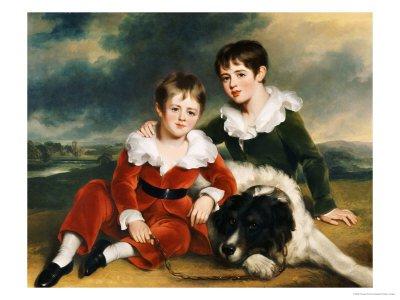Article: Children's Underwear in Regency England

Children's Underwear in Regency England
There they are, in portraits, paintings and engravings, with earnest faces and cute clothes. But what did they wear underneath? Surely not the whole understructure their parents wore?
 Just like their mothers, both boys and girls would have worn a chemise. This basic garment was usually made of linen, and followed the lines of the adult version, with one exception: Children’s chemises often omitted the side gussets, which added width to women’s chemises, thus being basically T-shirt shaped. On the other hand in well-to-do families they did even sport lace ruffles at the decollete and sleeve seams. Over the chemise followed a pair of stays.
Just like their mothers, both boys and girls would have worn a chemise. This basic garment was usually made of linen, and followed the lines of the adult version, with one exception: Children’s chemises often omitted the side gussets, which added width to women’s chemises, thus being basically T-shirt shaped. On the other hand in well-to-do families they did even sport lace ruffles at the decollete and sleeve seams. Over the chemise followed a pair of stays.
During the earlier Georgian period current medical opinion held that the tender bodies of infants had to be protected and shaped by stays, and in many costume collections we find heavily boned specimen made for children not even one year old. Towards the last quarter of the century, when enlightenment finally won the upper hand and children’s clothes began to show signs of classical influence long before they made their first appearance in ladies’ fashions, the small corsets became less resticting and less rigid, most of them being almost entirely unboned.
The garment itself was retained, however, serving a new purpose now: Since the children no longer had artifcially formed “hips”, other ways to keep the petticoats up were needed and found in buttons attached to the stays, on which the petticoats could be fastened.  Infants’ stays, 1780 - 1810, showing cording on the front and buttons to fix petticoats and pantalettes. The only two bones are in the back to strengthen the lacing. A plain under petticoat would have completed the underwear during the first half of the 18th century, there is no mention of drawers or pantalons yet.
Infants’ stays, 1780 - 1810, showing cording on the front and buttons to fix petticoats and pantalettes. The only two bones are in the back to strengthen the lacing. A plain under petticoat would have completed the underwear during the first half of the 18th century, there is no mention of drawers or pantalons yet.
There is also no evidence of formgiving understructures such as hooped petticoats or hip pads for children: With the simple lower class clothes they would not have been neccessary, and except for most formal occasions the more fashionable lines seen on portraits of better-off children can be achieved without such devices when contemporary and rather stiff silk fabrics are used for the garments themselves.
By the end of the century drawers made their first appearance in children’s clothing for both boys and girls. They were, like the underpetticoats, buttoned to the stays to keep them from sliding down. Another new item were pantalons or pantalettes, although it can be argued they are not truly underwear, as they were quite visibly peeping from under the dresses commonly worn by both sexes under the age of five. Somewhere between age three and seven, young boys were “breeched” and exchanged the infant’s dresses and pantalons for boy’s clothes such as the skeleton suit, usually also discarding their stays and chemises along the way. Clothing for girls just became gradually more like that of their mothers, the seams descending and (except for the very end of the Regency) the pantalettes vanishing. Stays (when worn) became more figure forming, and lost their buttons.
Ann-Dorothee Schlueter, Proprietress of Arts Et Metiers, in Germany is a textile historian and historical seamstress. She is registered with the Handwerkskammer, Berlin. Visit her website to see samples of her work and purchase items.
Enjoyed this article? If you don't want to miss a beat when it comes to Jane Austen, make sure you are signed up to the Jane Austen newsletter for exclusive updates and discounts from our Online Gift Shop.


Leave a comment
This site is protected by reCAPTCHA and the Google Privacy Policy and Terms of Service apply.